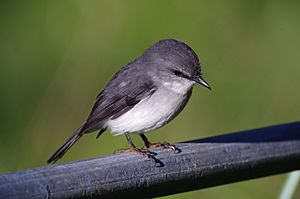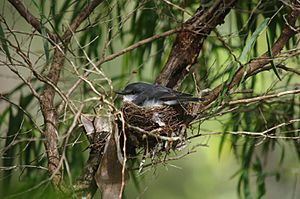White-breasted robin facts for kids
Quick facts for kids White-breasted robin |
|
|---|---|
 |
|
| In Western Australia | |
| Conservation status | |
| Scientific classification | |
| Genus: |
Quoyornis
|
| Species: |
georgianus
|
| Synonyms | |
|
Muscicapa georgiana Quoy & Gaimard, 1830 |
|
The white-breasted robin (Quoyornis georgianus) is a type of passerine bird. Passerine birds are often called "perching birds" or "songbirds." This robin belongs to the Australasian robin family, called Petroicidae. It is the only bird in its special group, known as the genus Quoyornis.
This bird lives only in southwestern Australia. This means it is endemic to that area. Unlike many other Australian robins, it does not have bright colors. It is mostly a grey bird with white feathers on its belly. Like other robins in its family, it is a cooperative breeder. This means other birds help the parents raise their young. The white-breasted robin stays in one place and does not migrate. Pairs or small groups of these birds keep their own territories.
Contents
About the White-breasted Robin
How It Got Its Name
The white-breasted robin was first described in 1830 by two French naturalists, Jean René Constant Quoy and Joseph Paul Gaimard. They named it Muscicapa georgiana. They found the bird near King George Sound, which is how it got its name.
Later, in 1846, another scientist named John Gould described it as Eopsaltria leucogaster. But because the first name was given earlier, georgiana is still its official species name.
In 1912, an Australian bird expert, Gregory Mathews, created a new genus (a group of similar species) just for this bird. He named it Quoyornis. This name combines Quoy's name with the Ancient Greek word ornis, which means 'bird'.
The official name for this bird is "white-breasted robin." This name was given by the International Ornithologists' Union. Even though it is called a "robin," it is not closely related to the robins found in Europe or America. The local Aboriginal people of Augusta call this bird boydjil.
What the White-breasted Robin Looks Like
The white-breasted robin is about 14.5 to 17.0 cm (5.7 to 6.7 in) long. Its wings can spread out between 22 and 25 cm (8.7 and 9.8 in). Male birds weigh about 20.5 grams, while females are a bit lighter at 16.5 grams.
Both male and female birds look similar. Their upper bodies are blue-grey, and they have lighter grey eyebrows. Their undersides are whitish. Their grey tail has a white tip. Their beaks and feet are black, and their eyes are dark brown. Birds that live in the northern part of their range are usually smaller and a darker grey. Young birds are brownish.
Where the White-breasted Robin Lives
The white-breasted robin lives in Western Australia. You can find it from Geraldton down to the southwest corner of the continent. It lives in two main types of places.
In the southern part of its home, it lives in tall forests. These forests have trees like karri (Eucalyptus diversicolor). The birds like to hide in the thick bushes and plants that grow under these trees. They often live near rivers and small valleys. They also live in drier forests with trees like jarrah (Eucalyptus marginata) and bull banksia (Banksia grandis). Here, they live in the bushes that are about 2 to 3 meters (6.6 to 9.8 ft) tall.
The birds in the northern part of their home live along the coast. They are found in a narrow strip from Geraldton down to Yanchep National Park. Here, they live in thick bushes near the ocean. These bushes grow on sand dunes over limestone soil.
White-breasted robins do not move around much. They stay in the same area. Pairs or small groups of birds keep their own territories. Young male birds often stay near their parents' territory for about a year. They act as helper birds. Young female birds usually leave the territory in their first year.
Life and Habits of the White-breasted Robin
Social Behavior
The white-breasted robin is a cooperative breeder. This means that a breeding pair often gets help from one or more other birds. These "helper" birds assist in raising the young. Most of these helper birds are male. Female birds are more likely to leave their home territory in their first year. Male birds are more likely to stay.
Reproduction
The breeding season for these robins is from late winter to early summer. They can raise up to two groups of young birds during this time. The nest is a neat cup shape. It is made from dry grass, bark, and spider webs. Nests are usually built in a tree-fork within dense bushes, often close to water.
The female lays two eggs. They are pale olive to blue-green in color. They often have darker spots. The eggs are about 16 mm by 21 mm (0.63 in by 0.83 in). One egg is often much paler than the other. The parents sit on the eggs for 16 or 17 days. The young birds leave the nest about two weeks after they hatch.
What They Eat
The white-breasted robin eats insects. It looks for its food mainly on or near the ground. It searches for insects in or under the bushes and plants.
See also
 In Spanish: Eopsaltria georgiana para niños
In Spanish: Eopsaltria georgiana para niños



